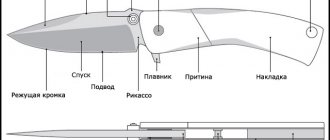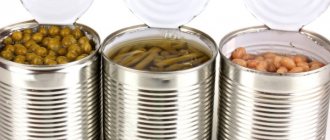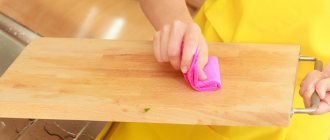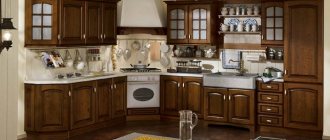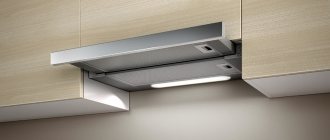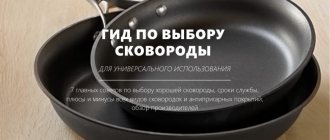/Accessories and decor/Cookware and cutlery/
Choosing a kitchen knife for professional chefs is a whole science with its own terminology, secrets and rules - after all, for them, a knife is almost an extension of the hand. We, ordinary people, do not need to understand all the intricacies of this science and have a full set of tools, but everyone can learn to distinguish good kitchen knives from bad ones and correctly create their own “chef’s troika”.
Which brand of kitchen knife should I choose?
- Nowadays you can see a large number of commercials where companies advertise their products. Many buyers, seeing the mark “Made in Germany” or “Made in Belgium”, immediately run to the store to purchase the product.
- However, not all advertising companies are responsible. Before buying a kitchen knife, study the manufacturer's information. Often, under the guise of a German or Japanese manufacturer, you buy low-quality Chinese goods. Quality imported knives will hold an edge for several years and come with a lifetime warranty.
Among the best brands for the production of kitchen knives are:
- Opinel. The company has been producing knives for about 100 years. All this time she does not give up the lead thanks to a good cut of the blade. Carbon and stainless steel are used to produce products. The cost of goods is reasonable;
- Victorinox . The company produces knives with good geometry and strength;
- Tramontina. The company is localized in Brazil. Its products are characterized by high-quality steel, light weight, ergonomics and correct geometry;
- Zolinger . The company produces blades that are sharpened by hand. They are characterized by blade strength, corrosion resistance and solid steel;
- Tojiro. The Japanese company sharpens the blades by hand, so the blade remains sharp for several years. The reasonable price allows both chefs and ordinary housewives to purchase such knives;
- Evercut and Sabatier . Companies from France produce durable and sophisticated blades;
- Del Ben. Unique tree species are used for the handles. The blades have an unusual and comfortable design.
Durable
The best manufacturers
Now that we have become familiar with the main models and their characteristics, let's look at which knife manufacturing companies are worth paying attention to.
- Japan - Yanagiba, Deba, Usuba, Demo, Masahiro, Tojiro, Mikadzo, Globall, Kai, Samura, Kiosera;
- Germany – Rondell, Wusthof, Fissler, Zwilling JAHenkels, BergHOFF;
- Brazil – Tramantina;
- Switzerland – VICTORINOX;
- Sweden – Eka, Frost;
- Italy – Delben;
- Spain - Arcos;
- Finland - Fiskars;
- USA – KithenAid;
- France – Savate;
- Russia - TimA; master Prokopenkov.
Sellers offering high-performance products under their own brand, quality custom-made in China.
The best ratio of price and quality:
- VICTORINOX;
- Arcos;
- Tramantino.
How to choose a good kitchen knife?
If you want to choose a high-quality kitchen knife, in addition to the manufacturer, you should consider other criteria.
Among them:
- type of steel;
- ergonomics;
- geometry.
The quality of the geometry determines how well the products will be cut. Give preference to a wedge shape and a thin blade . Then you can not saw the food, but smoothly cut it into pieces of the required size.
Ergonomics is an important detail when choosing a knife, as it ensures safety. It is important that the blade fits comfortably in your hand, does not slip, and does not rub.
How to choose steel for a kitchen knife?
Manufacturers use different materials for kitchen knives.
However, the most common are the following:
- Stainless steel. It does not require careful care, but it becomes dull very quickly. You will need to sharpen the blade at least once a month.
Characteristics of steel
- Carbon steel. The blade is durable, sharp and retains its sharpness for a long time. However, it requires careful care, as it quickly becomes covered with rust.
- Titan . Characterized by sharpness, elegance and resistance to rust or household acids. However, their cost is quite high.
Characteristics of titanium
In the hands of professional chefs you can notice knives from Damascus. They are very sharp and consist of different types of steel.
Manufacturing materials
High-quality kitchen knives are made from different grades of steel. It is sometimes difficult to choose the best one - focus on your tasks. There are two main options - stainless steel and high carbon steel. The first option quickly dulls and wears off, but is easy to maintain. The second one is prone to corrosion and fades over time. A good option is steel with the addition of chromium, molybdenum and vanadium.
Steel has its nuances: strong steel quickly dulls, hard steel crumbles and breaks. The following brands are popular:
- M390 – does not rust, sharpens well and has excellent strength characteristics;
- CPM S35VN is America's leader. The composition includes niobium;
- ZDP-189 is a Japanese brand, flexible and reliable. It is not recommended to hit with such a knife - it is inherently fragile.
High-quality kitchen knives are made from different grades of steel.
Which kitchen knife is better: steel or ceramic?
Such blades cannot be equated with each other. They differ in method of application and characteristics.
The advantages of ceramic kitchen knives include:
- Hardness and good sharpness, therefore do not require frequent sharpening;
- Homogeneous structure. When cutting different products, the taste of one does not transfer to another;
- Ease. The hand does not get tired during prolonged use;
- Resistant to corrosion and mechanical damage.
Ceramics
- The only drawback of ceramic knives is fragility . They should not be used for cutting frozen meat, bones or other hard foods. If you drop a knife from a height, it may break.
- Ceramic knives are very dangerous . When cutting food, a small piece of the blade may break off and fall into the dish. When you eat, it enters the esophagus and can cause health problems because it does not dissolve in stomach acid.
- Therefore, experts advise buying steel knives, because they are more durable and safer.
Types of kitchen knives
A good housewife should not have just one kitchen knife with which she prepares food. The kitchen should have a large number of knives that have different purposes.
Main types of knives:
- Bread . Must have a wide base and a long serrated blade. Suitable for slicing all bakery products.
- Standard . It has a length of 20-40 cm, a large blade, a sharp end and a rounded cutting part.
- Vegetable . It is characterized by a short blade, good sharpness and a smooth cut.
- For cheese and sausage . Quite long, and have a wide threaded part.
- For fish . The blade is medium sized and covered with serrations.
- For oil . It has a wide blade and a rounded end to make it easier to spread butter.
- Hatchet. Used for cutting meat. It has a large threaded part and a durable handle.
Knives
More knives have been designed for professionals. Main types:
- For salmon – characterized by a flexible and thin blade, allowing you to cut fish fillets into thin, almost transparent pieces.
- Slicer with grantons . It has holes in the blade to make it easier to cut fruits and cakes.
- For fillet . Used to separate fish or meat fillets from the bone.
- Boning . Used for cutting chicken.
- Slicer . Designed for cutting products into small pieces.
- Putty knife . Used to apply cream to the cake.
- Nakiri . Used for vegetable shredding.
- For tomatoes . Characterized by a serrated edge and a fork at the end. Chops tomatoes without squeezing out juice.
For tomatoes
Unusual knives
Knife shapes
What is a chef's knife and how does it differ from others?
The product is professional kitchen equipment, which is often used by chefs. It is one of the largest kitchen appliances: the length of the blade reaches 30 cm. Moreover, the mass of such a tool is less than that of simple knives.
The width of the blade allows it to be used as a spatula, with which crushed products can be moved.
Design dimensions of a chef's knife.
The main advantages are:
- versatility (types of equipment are provided for both men and girls);
- the opportunity to cook dishes from different cuisines of the world: Russian, European, Asian;
- increasing the speed of cooking.
Ceramics and steel are used in production. To make the product stronger, the parts that experience the heaviest load are hardened.
Types of handles for kitchen knives
- It is important to choose knives with a smooth, but non-slip handle. There are several types of handles for kitchen knives, which will be discussed in more detail below.
- The mounted handle is light weight and compact in size. The knife plunges into it. The cost of such products is not high. Disadvantages include a high probability of splitting. Choose handles so that the tail reaches the middle.
- There are also overhead handles. It is located on both sides of the blade, and is connected with rivets. Such products are quite reliable. It is important that the tail of the knife is long.
- are characterized by the most durable handles . They are firmly connected to the blade, so they do not deform. Disadvantages: heavy weight and high cost. The most comfortable handles are those made of heat-resistant plastic.
- The most commonly used material is Bakelite , which is quite cool to the touch. Wooden handles are convenient to use, however, they can become deformed from contact with water.
Handles
Features of choosing kitchen knives
When choosing a kitchen knife, it is important to consider many nuances.
The main ones include:
- Blade. Quality affects not only the cutting features, but also the ease of use. If you buy a blade with a flimsy base, there is a high chance that it will quickly become unusable. Give preference to products made of forged steel. They are more durable. Make sure there are no defects on the blade.
- Edge for cutting. There should be no mechanical damage on it. If there are irregularities (notches or waves), then the product is of poor quality.
- Handle. You can buy blades with handles made of plastic, metal or wood. Wooden handles are more comfortable, but quickly become unusable. Plastic products are strong and durable, however, they can feel awkward in the hand. Metal handles are more comfortable and practical. They can even be washed in the dishwasher.
Knife selection
- Sharpening. It is better to buy laser-sharpened blades. In the future, you will not need to sharpen the knives yourself.
- Fasteners. If there are rivets on the handle, they should be tightly screwed in and not stick out.
- Price. Give preference to more expensive products, because good quality cannot be cheap.
Price
- Ease of use. For a male chef, knives with a length of about 25 cm are suitable. For women, products with a length of 16 cm are suitable.
- Balance. The more balanced the knife is, the easier it will be for you to work with. However, they will be expensive. Place the knife on your finger on the bolster and try to balance it. If the blade does not fall, then you can purchase it.
Rating
To make it easier to decide on a model, we present to your attention a rating of ten successful universal products.
- Set of kitchen knives Rondell Kroner RD-459 for RUB 2,590.
- Set of kitchen knives Rondell Urban RD-1010 (3 pieces) for RUB 2,290.
- Set of kitchen knives Rondell Estoc RD-1159 for RUB 4,190.
- Set of kitchen knives Tefal Ice Force (K232S574) for RUB 7,990.
- Set of kitchen knives Rondell Glaymore RD-984 (5 pieces) for RUB 5,790.
- TalleR chef's knife Across TR-2020 for 395 rubles.
- Knife Tefal Ice Force (universal, 11 cm) for RUB 1,090.
- TalleR slicing knife TR-22021 for 690 RUR.
- Knife Tefal Ice Force (20 cm) K2320214 for RUB 2,290.
- Tefal Ice Force paring knife (7 cm) K2321214 for RUB 1,090.
How to properly store kitchen knives?
If you take proper care of your kitchen knives, they will last much longer.
There are several basic recommendations:
- Store blades so that they do not come into contact with each other or with other metal devices. Otherwise they will quickly become dull.
- Store on magnetic boards or stands that come with your knives from the manufacturer.
- Cut food on boards of either plastic or wood.
- Do not allow knives to remain in contact with water for long periods of time. After washing, immediately dry them with a towel to remove excess moisture.
- Do not wash in dishwasher . This will prevent dullness.
- Do not leave knives in the open sun. If you take them on a picnic , wrap the product in paper.
- Use blades only for their intended purpose.
Now you know how to choose the right kitchen knife so that it lasts for a long time. It is important to consider not only the blade and handle, but also balance. Give preference to more expensive products, as they are made of high-quality materials. Well-known manufacturers value their reputation, so they always provide a guarantee for their products. You don’t have to worry that the knife will become unusable after a few months of active use.
Kitchen themes on the site:
- Corner set for a small kitchen
- Japanese style in the interior of a bedroom, living room, kitchen
- How to cover the wall behind a gas stove
- How to clean grease from kitchen furniture
- How to combine colors in the kitchen interior
How to learn to cut quickly with a knife like a chef?
Before you begin, place a napkin soaked in water under the cutting board to prevent slipping. To hold the knife correctly when slicing, you need to grasp it tightly with your index finger and thumb at the junction with the blade. The sharpness of the blade is important for speed. First you need to learn how to chop correctly, then gradually increasing the speed, cut like a chef.
The fruit for training should be divided in half for stability and placed on a board. Take the cutter with one hand, hold the cutter with the other palm, fingers bent halfway, with the thumb hidden inside, constantly bending it and forming a “claw”.
Press the vegetable, the middle bone protrudes slightly. The blade blade touches the bone. Make gentle movements from top to bottom and towards yourself. Gradually move the vegetable forward, without removing the knife from your finger, and make a cut again.
You should not chop with small knives, as it is easier to injure yourself with them or the blade may get stuck in the pulp. Small products must be cut without removing the tip from the board, moving only the handle. The blade is not recommended for use for other work - cleaning or cutting bread products.
